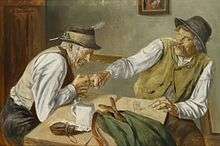Fingerhakeln

Fingerhakeln is an old athletic sports practiced in many regions, among them the Alps, predominantly Bavaria and Austria[1], Scandinavia and Finland.
When practicing Fingerhakeln, both opponents are sitting at a table opposite to each other and try to pull the opponent to himself on the finger over the table border. By physical force, overcoming the stretching pain and an appropriate technique, the opponent can be defeated. Usually, the opponents hook the middle fingers in a leather strap, in principle, however, every finger is allowed (except the thumb). Sometimes, also only the index fingers without strap are hooked into each other. Behind both hookers, two Auffänger (person who catches the opponent) are sitting. Additionally, there is a referee, a chairman and two assessors.
Allegedly, disputes were settled in this way in former times in countries of the Alps. Therefore, it becomes part in the tradition of European forms of sports before a wide standardization took place by gymnastics and sport.[2] In fact, Fingerhakeln is an organized sport in its present form. Leather straps (about 10 cm long and 6 to 8 mm strong), table (79 cm high, 74 cm wide and 109 cm long), stool (40 by 40 cm, 48 cm high) and distance between the middle line and the sideways lines (32 cm) are standardized. Every year, Bavarian, Austrian, German and Alpine championships in different weight and age classes are held.
The proverb Jemanden über den Tisch ziehen - with the meaning “to defeat, play off against someone” - has its origin in this popular sport in which not the force alone but especially the technique can decide.
References
- ↑ Peter, Ilka: Das Ranggeln im Pinzgau. Salzburg: Verlag der Salzburger Druckerei 1981.
- ↑ Arnd Krüger: Incorporating traditional games into modern sports. The German Experience. In: E. De Vroede, R. Renson (Hrsg.): Proceedings of the 2nd European Seminar on Traditional Games. Leuven 12 - 16 Sept. 1990. Vlaamse Volkssport Centrale, Löwen 1991, S. 45–54.
External links
| Wikimedia Commons has media related to Fingerhakeln. |
- „Fingerhakeln – nichts für Weicheier“, Bericht von den 52. Deutschen Meisterschaften in Stötten am Auerberg; RP Online vom 26. Juli 2011, abgerufen am 31. März 2012
- „Hermann Dreher holt beim Fingerhakeln in Stötten den deutschen Seniorentitel“, all-in.de – das allgäu online vom 26. Juli 2011, abgerufen am 31. März 2012